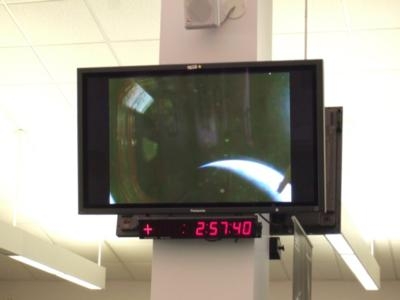A New Generation Of Journalists And Space Watchers Experience A Launch
By Wes Oleszewski
Sitting in the press room at the Kennedy Space Center and watching one of the four large flat-screen TV monitors, I found myself intently focused on the view being transmitted from the Orion spacecraft. The date was December 5th, 2014 and the unmanned Orion was coasting up-hill toward its orbital apogee of 3,602 miles above the Earth. Then, into view came an image of the crescent Earth. An unexpected chorus of amazement came from the reporters, "Whoa!"

Looking around the room I saw that the vast majority of reporters had their eyes locked on the TV monitors, as did all of the NASA and contractor personnel who were behind the information desk. Even the two astronauts who were present, Jack Fischer and Rex Walheim had their eyes locked on that image of the Earth. The room was otherwise silent. Looking back at the image it struck me that I had seen it before- on Apollos 10, 11, 12, 14, 15, 16 and 17. I grew up with live TV showing the earth from great distances. For a moment I sat back and looking around the room I realized that only a handful of us in the building had been around during Apollo. In fact I’m sure that of that crowd less than a half dozen had been old enough to follow Gemini and I know that only one person there had covered Mercury. No wonder this crowd was awe-struck.
Just over an hour later we were all watching live TV from the Ikhana drone aircraft as its camera tracked the descending Orion dropping back to Earth over the Pacific Ocean. This time I was also glued to the images and heard myself whispering, "Come on drogues, Come on drogues…" Suddenly the image switched to the Orion’s internal cameras again and through the rendezvous window we saw the two drogue chutes deploy. A cheer went up from the normally reserved press room followed by whistles and applause. It was something that I had never expected from that crowd. I held my exhilaration- the mains still needed to work.
For the longest minute and 23 seconds that I have experienced in recent years the Orion dropped on those drogues. During the descent NASA commentator Rob Navias proudly stated, "…there is your new spacecraft America." Two seconds later the drogues let go and the main chute deployment began. As the mains un-reefed wild applause and cheering took place in the press room and this time I was included. The three parachutes, each being 116 feet in diameter, slowed the Orion down to a speed of about 20 miles per hour.

As the vehicle was slowly descending toward the water I noticed that, although the hardcore KSC spaceflight reporters were at their desks, a large gaggle of "other" reporters were beginning to gather and surround astronauts Jack Fischer and Rex Walheim who had been watching the descent like the rest of us. As a final cheer broke out when Mission Control called "splashdown!" the crowd set upon the astronauts in a frenzy of questions. Two soundmen with microphones on poles, one standing on the information counter, were holding them inside this doughnut of media as the frenzy went on. For quite a while the two astronauts were held in this circle before the crowd began to break up. About ten minutes later I strolled over to Fischer and Walheim who were still a bit dazed.
"I guess they all thought that was the best splashdown that you guys ever made," I joked.
"That was weird," Fischer smiled, "they just came out of nowhere cameras and everything! I kept asking myself, do I have any food stuck to my chin or any bats in the cave?"
"I never saw that one comin’," Walheim snickered.
We all had a good laugh as the local "news at six" type media and foreign press were quickly packing up and leaving.
The final event of the day was the post launch press conference. Those of us who were dedicated to getting the full story in detail gathered in the auditorium. As NASA’s William Gerstenmaier; associate administrator for human exploration and operations, Mark Geyer; Orion program manager, Mike Hause; of Lockheed Martin, and Rex Walheim; astronaut walked into the room they were surprised to be met by applause and cheers from the hardcore space press. Everyone on the panel was clearly surprised by the reaction of the press.
For the first time since STS-135, the final flight of the space shuttle, the public flocked in overwhelming number to KSC to watch a space launch. Some people have asked "Why all of the attention?" after all this was just an un-manned space vehicle on a simple two-orbit four and one half hour mission. The answer is that, in spite of what the spaceflight critics and the Obama administration may say, America is a spacefairing nation and we Americans are a spacefaring people; it is generational. We want NASA to launch astronauts, we want our astronauts to launch from American soil and we find it objectionable that our astronauts are forced to rent seats on Russian spacecraft while our own spacecraft are placed into museums. Private companies can do their best and may someday fly crews- an accomplishment that Americans will approve of, yet the American public will still want NASA to push the boundaries of space and launch our explorer astronauts.

Following the cancellation of Apollo just two years passed before the shuttle Enterprise was taken aloft by a Boeing 747 and released on a simple glide flight to the runway at Edwards Air Force Base. Yet throngs of Americans including celebrities and politicians flocked to Edwards just to get a glimpse of what was little more than a hollow engineering test article with working control surfaces and computers glide back to the ground in a five minute flight. Three and a half years after that as many as a million people lined the causeways, beaches and river banks around KSC to see the first real Space Shuttle launch. I was one of them and in spite of critics calling for the cancellation of the program and spreading the myth that using the money spent there would feed "all" of the hungry in America, the shuttle Columbia flew and we Americans cheered. We cheered because we are a spacefaring nation and a spacefaring people. It is a part of our way of life and no president with a pen can take that away from
us. This week Orion flew into deep space and spacefaring Americans cheered- even those in the hardcore spaceflight media.
(Top image provided by the author. Others courtesy NASA)
 Airborne 04.16.24: RV Update, Affordable Flying Expo, Diamond Lil
Airborne 04.16.24: RV Update, Affordable Flying Expo, Diamond Lil ANN's Daily Aero-Term (04.20.24): Light Gun
ANN's Daily Aero-Term (04.20.24): Light Gun Aero-News: Quote of the Day (04.20.24)
Aero-News: Quote of the Day (04.20.24) Aero-News: Quote of the Day (04.21.24)
Aero-News: Quote of the Day (04.21.24) ANN's Daily Aero-Term (04.21.24): Aircraft Conflict
ANN's Daily Aero-Term (04.21.24): Aircraft Conflict





